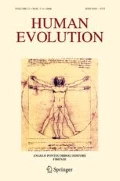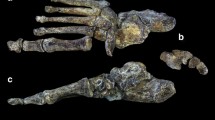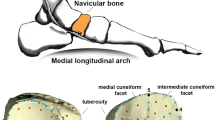Abstract
Early hominid feet are often very fragmentary preserved and their architectural approaches stayed limited and subject to controversy. This study proposes an architectural analysis of the primate foot realised on dislocated skeleton. It is based on the angular analysis of geometrical relationships between the joint areas. We investigate the longitudinal structure of the primate foot and we present the results concerning someAustralopithecus afarensis specimens from Hadar (Ethiopia) and theHomo habilis Olduvai Hominid 8 foot (Tanzania). The architectural analysis argues for the lack of a longitudinal medial arch inA. afarensis, their joints being in neutral position. On the contrary, the more recent OH8 specimen is arched both medially and laterally.
Similar content being viewed by others
References
Aiello L., Rye P., Wood B., 1996 — The OH8 first metatarsal.American Journal of Physical Anthropology, Sup. 22, 59.
Archibald J.D., Lovejoy C.O., Kinsbury G.H., 1972 — Implications of relative robusticity in the Olduvai Metatarsus.American Journal of Physical Anthropology, 37, 93–96.
Berillon G., 1999. Geometric pattern of the hominoid hallucal tarsometatarsal complex. Quantifying the degree of hallux abduction in early hominids.Comptes-Rendus de l’Académie des Sciences, Paris, Série IIa, 328, 627–633.
Berillon G., 2000 —Le pied des hominoïdes miocènes et des hominidés fossiles. Architecture, locomotion, évolution. Paris, CNRS,Cahiers de Paléoanthropologie, 166 p.
Bojsen-Møller F., 1979 — Calcaneocuboid joint stability of the longitudinal arch of the foot at high and low gear push off.Journal of Anatomy, 129, 1, 165–176.
Clarke R.J., Tobias P.V., 1995 — Sterkfontein Member 2 foot ones of the oldest south African hominid.Science, 269, 521–524.
Day M.H., Napier J.R., 1964 — Hominid fossils from Bed I, Olduvai Gorge, Tanganyika. Fossil foot bones.Nature, 201, 969–970.
Day M.H., Wood B.A., 1968 — Functional affinities of the Olduvai Hominid 8 talus.Man, 3, 440–454.
Deloison Y., 1986 — Description d’un calcaneum fossile de primate et sa comparaison avec des calcaneums de Pongidés, d’Australopithèques et d’Homo.Comptes-Rendus de l’Académie des Sciences, Paris, 302, série III, n 7, 257–262.
Deloison Y., 1993 —Etude des restes fossiles des pieds des premiers hominidés: Australopithecuset Homo habilis.Essai d’interprétation de leur mode de locomotion. Thèse de Doctorat d’Etat es Sciences, Université René Descartes, Paris, 783 p.
Elftman H., Manter J., 1935 — The evolution of the human foot, with especial reference to the joints.Journal of Anatomy, 70, 56–70.
Harcourt-Smith W.E.H., Aïello L.C., 1999 — An investigation into the degree of hallux abduction of the OH8 foot.American Journal of Physical Anthropology, Supplement 28, 145.
Henderson A., Wood B.A., 1977 — The functional anatomy of the Olduvai (OH 8) foot.Journal of Anatomy, 124, 252.
Lamy P., 1986 — The settlement of the longitudinal plantar arch of some African Plio-Pleistocene Hominids: a morphological study.Journal of Human Evolution, 15, 31–46.
Langdon J.H., Bruckner J., Baker H.H., 1991 — Pedal mechanics and bipedalism in early hominids. InOrigine(s) de la bipédie chez les Hominidés, B. Senut et Y. Coppens eds., 159–167, Paris, CNRS,Cahiers de Paléoanthropologie.
Latimer B., Lovejoy O., 1989 — The calcaneus ofAustralopithecus afarensis and its implications for the evolution of bipedality.American Journal of Physical Anthropology, 78, 369–386.
Latimer B., Lovejoy O., Johanson D.C., Coppens Y., 1982 — Hominid tarsal, metatarsal and phalangeal bones recovered from the Hadar formation: 1974–1977 collections.American Journal of Physical Anthropology, 57, 701–719.
Latimer B., Ward C.V., 1998 — Locomotion inAustralopithecus: evidence from the leg and foot.Abstract on Contributions to the Dual Congress 1998, 28 june-4 july 1998, Sun City, South Africa, 22–33.
Leakey L.S.B., 1960 — Recent Discoveries at Olduvai Gorge.Nature, 188, 1050–1052.
Leakey L.S.B., Tobias P.V., Napier J.R., 1964 — A new species of the GenusHomo from Olduvai Gorge.Nature, 202, 7–9.
Lewis O.J., 1980 — The joint of the evolving foot. Part III. The fossil evidence.Journal of Anatomy, 131, 275–298.
Lisowski F.P., 1967 — Angular growth changes and comparisons in the primate talus.Folia Primatologia, 7, 2, 81–97.
Lisowski F.P., Albrecht G.H., Oxnard C.E., 1974 — The form of the talus in some higher Primates: a multivariate study.American Journal of Physical Anthropology, 41, 191–216.
Lisowski F.P., Albrecht G.H., Oxnard C.E., 1976 — African fossil tali: further multivariate morphometric studies.American Journal of Physical Anthropology, 45, 5–18.
Oxnard C.E., 1972 — Some African fossil foot bones: a note on the interpolation into a matrix of extant species.American Journal of Physical Anthropology, 37, 3–12.
Oxnard C.E., 1979 — Convention and controversy in human evolution.Homo, 30, 225–246.
Oxnard C.E., Lisowski F.P., 1980 — Functional articulation of some hominoid foot bones: implications for the Olduvai (Hominid 8) foot.American Journal of Physical Anthropology, 52, 107–117.
Stern J.T., Susman R.L., 1983 — The locomotor anatomy ofAustralopithecus afarensis.American Journal of Physical Anthropology, 60, 279–318.
Susman R.L., Stern J.T., 1982 — Functional morphology of Homo habilis.Sciences, 217, 931–934.
Susman R.L., Stern J.T., Jungers W.L., 1984 — Arboreality and bipedality in the Hadar hominids.Folia Primatologia, 43, 113–156.
Walter R.C., 1994 — Age of Lucy and the first family: single-crystal 40Ar/39Ar dating of the Denan Dora and Lower Kada Hadar members of the Hadar Formation, Ethiopia.Geology, 22, 6–10.
Walter R.C., Manega P.C., Hay R.L., Drake R.E., Curtis G.H., 1991 — Laser-fusion 40Ar/39Ar dating of Bed I, Olduvai Gorge, Tanzania. Nature, 354, 145–149.
Wood B.A., 1974a — AHomo talus from East Rudolf.Journal of Anatomy (London), 117, 203–204.
Wood B.A., 1974b — Evidence of locomotor pattern of Homo from early Pleistocene of Kenya.Nature, 251, 135–136.
Author information
Authors and Affiliations
Rights and permissions
About this article
Cite this article
Berillon, G. Assessing the longitudinal structure of the early hominid foot: A two-dimensional architecture analysis. Hum. Evol. 18, 113–122 (2003). https://doi.org/10.1007/BF02436280
Received:
Accepted:
Issue Date:
DOI: https://doi.org/10.1007/BF02436280




